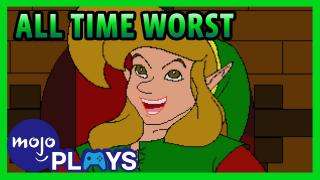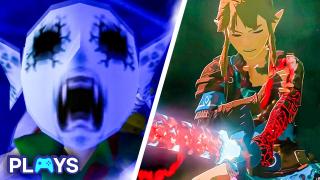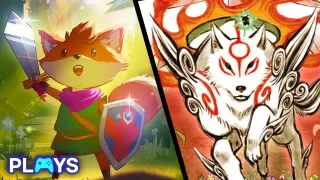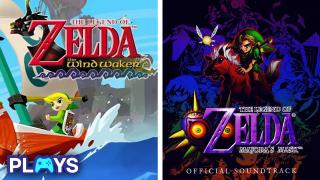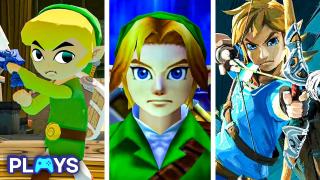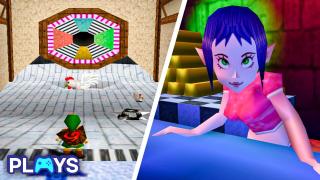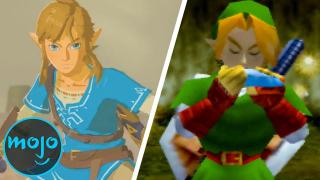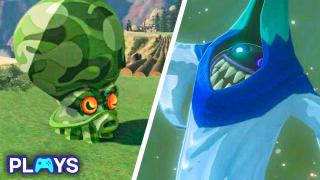The 8 Worst Legend of Zelda Games Ever
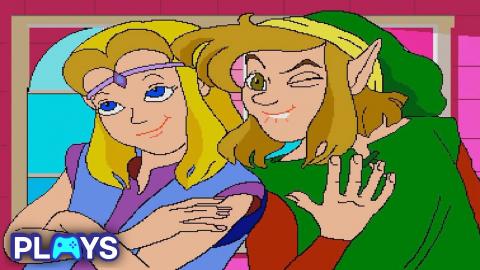
The 8 Worst Legend of Zelda Games
The Absolute WORST ZELDA Game?
Welcome to MojoPlays, and today we’re looking at the Worst Legend of Zelda Games. For this list, we will be focusing on the weakest releases in a franchise that has a track record that is beyond impressive. In the comments, let us know what your least favorite "Zelda" game is, and why!
“Zelda II: The Adventure of Link” (1987)
The 10 WORST Things That Have Happened To Link in The Legend of Zelda
After creating magic with 1986's "The Legend of Zelda," Nintendo decided to try something different for the sequel. Unlike the rest of the main games, "Zelda II: The Adventure of Link" is mostly a side-scroller that places far more emphasis on combat than puzzles. The plot and characters might be typical "Zelda," but "The Adventure of Link" is very much its own beast. With solid RPG elements and an enjoyable magic system, "The Adventure of Link" is a pretty good, albeit difficult game when viewed in a vacuum. As part of the larger "Zelda" franchise, the original sequel feels out of place and seems almost like a spin-off. Fun can be had with "The Adventure of Link," as long as someone does not go in expecting classic Zelda fare.
“The Legend of Zelda: Four Swords” (2002)
10 Games To Play If You LOVE The Legend of Zelda
Released as a package with the Game Boy Advance version of "A Link to the Past," "Four Swords" brought multiplayer to the franchise. While naturally overshadowed by its counterpart, "Four Swords" is still an innovative entry in the series. Along with introducing Vaati, the game features randomly generated dungeons, multiple endings, and teamwork-based puzzles. As a standalone experience that can only be played with multiple Game Boy Advances, "Four Swords" ultimately requires too much effort for a game that falls short compared to most other "Zelda" titles, including the GameCube's "Four Swords Adventures." In 2011, Nintendo released a remaster of "Four Swords" that also came with a single-player mode, but this version was only made available for a limited time.
“Tingle's Balloon Fight DS” (2007)
It’s difficult to be too critical of "Tingle's Balloon Fight," a game that was released as a Japanese-exclusive reward for Club Nintendo members. "Balloon Fight" is considered a classic for a reason, and adding Tingle and the Nintendo DS to the mix does nothing to ruin the experience. This version looks good on the system, has an impressive amount of stages, and even offers multiplayer. In many ways, this is one of the better ways to experience "Balloon Fight;" however, the game is unlikely to serve as anything more than a way to kill a few minutes. Compared to Tingle's other spin-offs, "Balloon Fight" doesn’t have much personality.
“The Legend of Zelda: Tri Force Heroes” (2015)
The 10 BEST Legend of Zelda Soundtracks
When the stars align, "Tri Force Heroes" is a solid but unspectacular "Zelda" game, one designed with three-player co-op in mind. Playing locally with friends should provide a relatively smooth experience, even if the mission-based structure and smaller levels strip the campaign of that sense of adventure synonymous with most "Zelda" titles. Unstable servers and random players mean that online play is always a gamble, and time is "Tri Force Heroes'" greatest enemy in this area. Nintendo did future-proof the game by making solo play possible, as a single person can control all three Links. It’s just that the single-player never manages to be anything more than functional.
“Link's Crossbow Training” (2007)
The Legend of Zelda: Every Version of Link Ranked
Unlike some other Nintendo properties, "The Legend of Zelda" does not indulge in spin-offs all that often, which is the only thing that makes "Link's Crossbow Training" interesting. Sold alongside the Wii Zapper peripheral, this score-based shooter serves as a moderately entertaining romp that is mostly worth playing for those who wish to revisit "Twilight Princess" in some other form. With 27 stages spread across nine levels, "Link's Crossbow Training" is shorter than some of the tutorial sequences of the mainline games, and the multiplayer does little to extend the playtime. It does its job as a tech demo for the Wii Zapper, but it does not amount to much more than that.
“Zelda's Adventure” (1994)
The 10 HARDEST Zelda Mini Games
In the early '90s, Nintendo almost partnered up with Philips to create a CD-ROM add-on for the SNES. Although this deal fell through, Philips was allowed to use the "Zelda" IP to create three games for its CD-i console; in turn, Nintendo could rest easy knowing it would never be directly responsible for the worst "Zelda" games. As the final entry in the CD-i trilogy, "Zelda's Adventure" tries to ape the traditional "Zelda" formula by incorporating a top-down view; however, the game does such an underwhelming job that any similarities can only aspire to be deemed superficial. The game is a slog hampered by poor controls, confusing goals, and boring gameplay. Out of the three CD-i games, this tends to get the least attention, but that mostly comes down to the fact it’s bad rather than hilariously bad.
“Zelda: The Wand of Gamelon” (1993)
Top 10 Legend of Zelda Games of All Time
Starting on a somewhat positive note, "The Wand of Gamelon" flips the script on its head by presenting Link as the damsel in distress and Zelda as the hero. The game's backgrounds look decent, the soundtrack is fine, and the bosses are closer to puzzles than normal fights, which is a neat idea. Unfortunately, things begin to fall apart the second a controller is picked up, as the side-scroller's controls zap out most of the potential fun the game might have to offer. The stages are overloaded with enemies and can be indiscernible at times, while the animated cut-scenes are so bizarre, they almost become entertaining.
“Link: The Faces of Evil” (1993)
The 10 Most Annoying Legend of Zelda Enemies
Compared to its Princess-starring sibling, "Link: The Faces of Evil" is a more straightforward and action-driven experience. This side-scroller is all about Link rampaging through Koridai's various dungeons, leaving behind nothing but stabbed and blown up corpses. This would be fine if the game could back up its combat-focused structure with serviceable controls; sadly, Link at times feels like he has a mind of his own, and the protagonist does not know the meaning of self-preservation. "The Faces of Evil's" laughable cut-scenes are by far the highlights of this otherwise frustrating and exhausting adventure.


